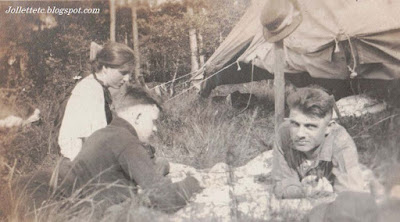You’ve heard of “Throwback Thursday.” Consider this
“Throwback Month.” While on vacation, it is impossible to do new research and
post fresh stories, so for now, please enjoy a “throwback” from 2012.
The Jollett Cemetery is located on a hill
behind the Jollett United Methodist Church in Jollett Hollow in
Page County, Virginia.
Before I started my research on the Jollett family, I
always assumed this is where the bulk of my ancestors were buried. After all,
Fielding Jollett lived along Naked Creek from 1822 until he was too old to live
alone sometime after 1870. He owned land there and sold it to his
children. This was the stomping grounds
of MY line. The area was named for them. It stands to reason they’d die and be
buried there, right?
As it turns out, most of my ancestors through my
great-great grandfather James Franklin Jollett are not buried in the Jollett
Cemetery at all, rather in Coverstone Cemetery in Shenandoah, Virginia. James Franklin
himself is in a church cemetery in Augusta County. The few Jolletts who are in
the Jollett Cemetery are actually the family of James Franklin’s brother John
Wesley Jollett.
The land where the church and cemetery are located
originally belonged to Revolutionary War veteran Jacob Smith and his wife Winna.
Upon their deaths the land went to their youngest son Gabriel Smith. Then in
1866, Gabriel’s widow sold the land to John Wesley Jollett who had married Sarah
Elizabeth Smith, Jacob and Winna’s great granddaughter.
John Wesley Jollett was a much loved Methodist minister. He
gave the land for the church and the cemetery to the Methodist Conference. While
the area bears his name, there are only three tombstones with the name Jollett.
Sarah E. wife of
Rev. J. W. Jollett
Died Jan 30 1917
Aged 82 Yrs
8 M and 8 DS
Rev. J. W. Jollett
Died Oct 18 1916
Aged 84 yrs
6 M and 12 DS
Precious in the sight of the Lord is
the death of His saint
John and Sarah’s two daughters are there as well, but
only one son is buried in the Jollett Cemetery.
 |
| "We will meet again" |
To the Memory
of
Artubine J.
Son of John and
Elizabeth
Jollett born
Dec the 16th 1853
and died Oct 27
th 1862 aged 8
years, 10 months,
and 11 days
Most of the graves in the Jollett Cemetery are of descendants of Jacob and Winna
Smith.
Except for paved roads and more modern brick houses, this
rural area probably looks much like it did in the 1800s.
Amy Johnson Crow continues to challenge genealogy
bloggers and non-bloggers alike to think about our ancestors and share a story
or photo about them. The challenge is “52 Ancestors in 52 Weeks.”
Wendy
© 2019, Wendy Mathias. All rights reserved.




















































